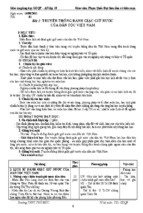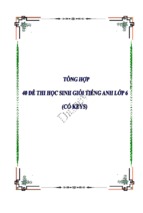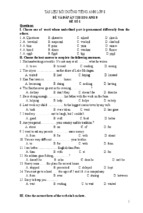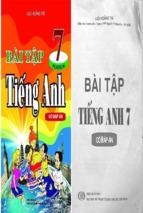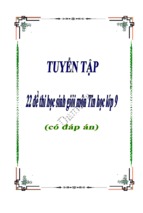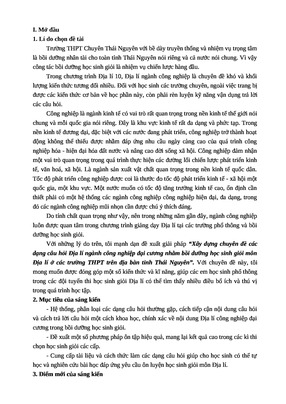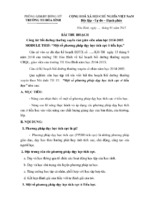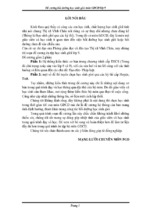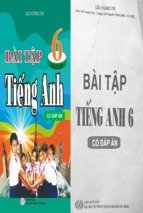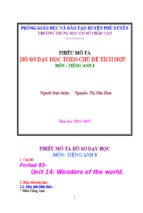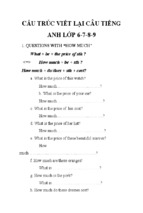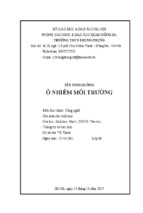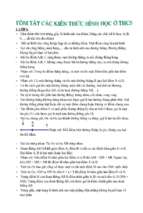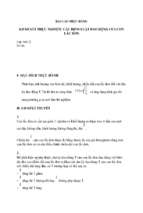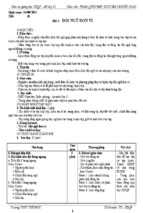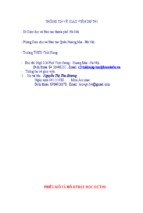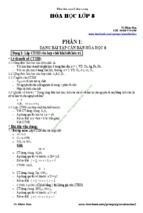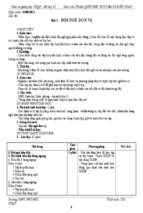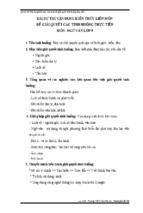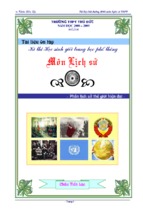INDEX
Contents
1. Preamble.
1.1. Reasons for choosing the theme.
1.2. The purposes of research.
1.3. Subject of research.
1.4. Research methodology.
2. Contents.
2.1. Theoretical background.
2.2. The status of the problem.
2.3. Solutions and implementation.
2.4. Achievements.
3. Conclusions and recommendations.
3.1. Conclusions
3.2. Recommendations.
References
A list of teaching experience initiatives
Page
1
1
1
2
2
2
2
3
3
11
12
12
12
14
15
1. Preamble
1.1. Reasons for choosing the theme.
English has been chosen as the international language and many countries
use the most. It becomes the native language of more countries, the language of
human beings’ communication worldwide.
With the trend of international integration, Vietnam is increasingly
promoting the availability of its all abilities in all fields. Today, English plays an
increasingly important role. Therefore, Vietnamese education attaches great
importance and puts the English program as a core subject in the education level
courses in the education system.
We also see the position of the course for the development of the whole
society: as a tool to facilitate integration with the international community and
the region, access to information and advance science and technology, access to
other cultures as well as an important international event. English program in
secondary level to the formation and development of students with the
knowledge and basic skills in English and intellectual qualities need further
studying or traveling higher up into working life.
As we see the magic of human beings is to use language not only to
communicate but also to combine language sounds to create something that stirs
the heart and mind that we called music. Thus, in the native language teaching in
general and teaching foreign languages - English in particular will be very
interesting and effective if we use some songs fit into the specific class.
I myself, in the position of a teacher of English in secondary school,
through several years of working, I know the method characterized by their
respective departments track. I always research, improve the quality of teaching
and studying English, especially with distant regions and with many difficulties
as Luan Thanh, a mountainous commune of Thuong Xuan district.
I noticed at this psychology age, most of these children are very fond of
singing, it was demonstrated in the details of their favorite music lessons.
Especially if they can sing a song in English language not only brings
excitement of learning that language knowledge but it is also etched forever in
their minds. Because of these concerns, I have boldly choosen the theme, that
is: "Using songs to teach some English vocabularies and structures for
grade 6 students at Luan Thanh Secondary School” in order to help students
learn and remember vocabularies together with new structures more easily.
1.2. The purposes of research.
From the current status of teaching new English vocabularies and
structures over the years at secondary school where I am working, I have
improved a positive teaching method appropriate to each lecture and student.
But the scale of this subject I have no ambition and not enough time to make all
the methods of teaching and learning English vocabularies, with the hope that
this approach can help the students learn, practice and hone another to make
1
some necessary vocabularies. Thereby, they gain experience easier in learning
and practicing their vocabularies.
1.3. Subject of research.
Because of limited time, I just mentioned applies the method of teaching
and revising new vocabularies and structures in a number of lessons in grade 6
for Luan Thanh secondary school’s students in this topic.
1.4. Research methodology.
- Theoretical research methods: Research documents and curricula related
to research problems by means of analysis, synthesis, comparison to draw the
theoretical issues-oriented nature as a basis for solving problems and tasks
study.
- Survey method: Find out the status of teaching and learning of teachers
and students acquire specific knowledge in order to detect the problem to be
solved, determine the popularity, in preparation for the next research step.
- Conversational method: Talking to colleagues about the advantages and
difficulties in teaching and using new methods available today.
- Observation method: Through the project more time colleague, his own
lessons in school, good teachers’ competitions at district and province to be able
to directly observe the situation of students. Thereby, learnable ability to acquire
all, capture knowledge through lectures. Besides, learning receptive colleagues
in the district as well as other areas through the Internet and found out the
limitations of teaching.
- Test method evaluation: Through the lessons of myself, of positive test
career and student surveys.
2. Contents.
2.1. Theoretical background.
In current socialization, learning English is a huge demand of students,
especially in the period of integration, the need to communicate in English is
essential. The goal of education is currently focused on the development
direction of the dynamism, creativity and positive in order to enable students to
identify and solve the problem for them. How students can confidently apply an
effective way the knowledge they have learned in their life? This is the goal that
the education is always towards to.
Stemming from the above requirements, we may find that the importance
of offering courses taught in English in education is undeniable. But how can
students acquire language in the most effective way, especially when catering
facilities for teaching and learning this subject has not yet been fully met? This
requires a lot of factors but the most important is still students’ passion to
English and teachers must have appropriate, attractive and charismatic teaching
methods to students.
2
2.2. The status of the problem.
Each the school's English Department has its own characteristics, causing
amorous curiosity of many students learning but also inevitably cause
difficulties dampened apprentice position. Therefore, teachers must pay
attention to all of students interested in learning English.
Stemming from the point '' learner-centered '', methods of teaching and
learning have made fundamental changes. The teacher is not the only one who
holds the knowledge and imparts knowledge that is only a guide, facilitator,
mentor and checkers. Learners no longer a passive acquisition of knowledge
which is the center of the teaching process, initiatives and creativity in the
learning process to achieve high results in learning and know how to apply in
real life.
General language teaching, teaching English in particular the renewal of
teaching methods is crucial. To master the language knowledge, implement 4
skills of listening, speaking, reading and writing was very difficult for them,
especially for the 6th grade students to be acquainted with the discipline
department. Because they do not have many new vocabularies and structures to
use.
From the point on the use of appropriate songs for the lessons to help the
students are extremely interested in the subject, especially help them much
easier to memorize new words and structures.
2.3. The solutions and implementation.
Basing on the above concerns, I thought and found out a number of
measures for the implementation of the project.
Firstly, I carefully selected the songs and did not use them widespread. I
considered the time of each lesson and students of each class to use a suitable
song. I borrowed the music songs may be familiar to children's Vietnamese
music, the music can also be the English Children’s music or US such as
“Behold gold butterfly”, “If you're happy and you know it”, or the music that I
have collected from textbook "English time 1, 2, 3, 4, 5, 6", or through the
Internet. On the other hand, I will change their words which are suitable to the
content structure of sentences or vocabularies in each lesson. Especially, after
each song in the book, I can give it to them to replace the song with the
vocabularies of the same theme, as this may help them create and expand
vocabularies naturally.
Secondly, I copied the entire lyrics of the songs and composed them into a
song to teach in the order as arranged in the CDs.
Thirdly, depending on the specific songs, I chose the right equipment so
as not to waste time preparing. Sometimes, I used the projector for students to
see the pictures vividly. At times, only a set of mini speakers and USB, wired
phone jack available, or a personal laptop and a personal mini speaker, or
sometimes I did not use a device at all.
3
Finally, I improve my music skills, so I can confidently sing the sample
song in front of my students if they ask.
The method of using songs is really exciting for students, so the teacher
should create the conditions for many children to participate in singing in front
of the class especially for the poor students. We can call each group, each pair or
each student to sing, then give them points for encouragement.
We can also ask students to listen to the songs, together with singing
along, performing the movements following the melody of the songs.
Depending on the knowledge in the songs, it is necessary to deliver the
songs at the suitable time of the lessons, may be at the beginning of the period,
in the middle or in the end of each lesson. Here are some examples that I have
successfully applied.
- Example 1: Unit 1: Greeting
To review or practice for students the greetings, name question, or
question about one’s health, I used the following songs:
“The hello song”
Hello, hello, hello!
What's your name?
Hello, hello, hello!
My name is Nam.
My name is Nam.
Hello, Nam
Hello, Nam!
Hello
Basing on the below song, students turn in turn to sing his/her name in
order to drill and sample salutation name questions.
Hello, hello, hello!
What's your name?
Hello, hello, hello!
My name is Lan.
My name is Lan.
Hello, Lan!
Hello, Lan!
Hello
After that, I let students listen to the song “How are you?”
Hello, Peter. How are you?
I’m fine, thank you. How are you?
Thank you , Peter. I’m fine, too.
Let’s go to school together.
4
How are you Ba, Lan and Nga?
Thank you, Miss Hoa, we’re fine.
- Example 2: Unit 1: B. Good morning.
I used the song: “Good morning”
Good morning.
Good morning to you.
Good morning to you. Good morning dear children.
Good morning to you.
Good morning to you. Good morning to you.
Good morning dear teacher. Good morning to you.
Then I got them replacing the lyrics on the phrase with “Good afternoon;
good evening or good night" to practice the greetings.
- Example 3: Unit 1: C. How old are you?
Students listen to the tape all the number from one to twenty, they repeat
at the second listening, the third one, I let them listen to this song. They can sing
along, clap the hands and jump up at the end of each sentence of this song:
“Let’s count from one to twenty”
One, two, three, four, five, jump.
Six, seven, eight, nine, ten, jump.
One, two, three, four, five, jump.
Six, seven, eight, nine, ten, jump.
Eleven, twelve, thirteen, fourteen, fifteen, jump.
Sixteen, seventeen, eighteen, nineteen, twenty, jump.
Eleven, twelve, thirteen, fourteen, fifteen, jump.
Sixteen, seventeen, eighteen, nineteen, twenty, jump.
- Example 4: Unit 2: A. Come in
I used the song "Open your book" to perform the movements illustrated
below:
Open the book. (Use two hands to open the book.)
Close the book. (Use two hands to close the book.)
Open the door. (Use one hand to open the door.)
Close the door. (Use one hand to close it.)
Open the bag. (Use one hand to open the folder) (open horizontally)
Close the bag. (one hand using paired horizontally) (as opposed to
open)
Open the window. (Use two hands to open the windows) (such as
exercise hand movements.)
Close the window. (Use two hands to close the window) (as
opposed to open.)
5
- Example 5: Unit 2: B. Where do you live?(B3)
After teaching how to pronounce all the letters from “a” to “z”, I let
students listen and sing the song “The alphabet song”, then I called some
students to sing the song in front of class.
“The alphabet song”
ABCDEFG
HIJKLMNOP
QRSTUV
WXYZ
Now I know my ABCs.
- Example 6: Unit 3: At home (A3,4,5)
I used the song "The family song", I encouraged students to replace the
words of family members similar to these:
a/ Who’s he? He’s my father. Who’s he? He’s my brother.
Who’s he? He’s my grandfather.
This is my family.
b/ Who’s she? She’s my mother. Who’s she? She’s my sister.
Who’s she? She’s my grandmather.
This is my family.
…
- Example 7: Unit 3: C. Families
I used the song “Two kind doctors”, I let the students listen to the song
once, I divided class into groups and gave them the pictures of different jobs.
The second listening, I replaced the lyrics with different words, students of the
groups listened to the name of the group of occupations, they had to raise the
right picture.
Two kind doctors meet in a land. (students raised this picture)
Hello, hello, What's your name?
How are you? How are you? How are you again?
Two kind farmers, meet in a land, (students raised this picture)
Hello, hello, What's your name?
How are you? How are you? How are you again?
6
Two kind of nurses, meet in a land. (students raised this picture)
Hello, hello, What's your name?
How are you? How are you? How are you again?
Two kind of teachers, meet in a land. (students raised this picture)
Hello, hello, What's your name?
How are you? How are you? How are you again?
7
Two kind workers, meet in a land. (students raised this picture)
Hello, hello, What's your name?
How are you? How are you? How are you again?
Two kind students, meet in a land. (students raised this picture)
Hello, hello, What's your name?
How are you? How are you? How are you again?
We can use variety of different vocations to make a long but easyunderstanding song.
- Example 8: Unit4: C: Getting ready for school.
So as to teach students some daily activities, I used the song:
“This is the way we go to school”.
8
This is the way we go to school
Go to school, go to school.
This is the way we go to school
So early in the morning.
This is the way we brush our teeth
Brush our teeth, brush our teeth
This is the way we brush our teeth
So early in the morning.
…
I asked students to use other vocabularies (such as: wash my face, have
breakfast, get dressed, take a shower…) to change the above song.
- Example 9: Unit 5: C. Classes.
I used the song: “How many days in a week?” to help students practice
the days in a week as well as revise the question of time.
How many days in a week?
How many days ?
How many days ?
How many days in a week?
Sunday, Monday
Tuesday, Wednesday
Thursday, Friday, Saturday.
What time is it?
What time is it?
It's six o'clock.
It's time to get up.
What time is it?
It's six fifteen.
It's time for breakfast.
What time is it?
It's six forty-five.
It's time for school.
- Example 10: Unit 9: The body
I used the song "Ten fingers on my hands”, then they replaced the
lyrics with words such as the following:
Ten fingers on my hands, on my hands,
Ten fingers on my hands, on my hands, (Students sing out with
spreading ten fingers, clap their hands)
Two eyes, one nose all on my face. (pointing to the eyes, pointing
to the nose then pointing to the face)
Ten fingers on my hands, on my hands.
9
Students replaced the underlined words into a new post with the above
gestures.
Ten toes on my feet, on my feet.
Ten toes on my feet, on my feet.
Two legs, two knee all on my body.
Ten toes on my feet, on my feet.
…
- Example 11: Unit10: A. How do you feel?
I used the song: “ If you’re tired and you know it”.
If you're happy and you know it, clap your hands (clap clap)
If you're happy and you know it, clap your hands (clap clap)
If you're happy and you know it, then you really ought to show it
If you're happy and you know it, clap your hands. (clap clap)
After singing the song, we can replace “happy” by different feeling words
such as hungry, thirsty, cold, tired…, so the song will continue to be lengthened
and the vocabularies are also easier to remember.
- Example 12: Unit 10: C. My favorite food.
After teaching new vocabularies and new structure, I let students listen to
the song: “My favourite food and drinks”
What's your favourite food? What's your favourite food?
Hey ho hey ho, my favourite food is beef.
What's your favourite drink? What's your favourite drink?
Hey ho hey ho, my favourite drink is milk.
Beef and milk, beef and milk.
Hey ho hey ho, they’re my favourite food and drink.
Basing on the song above, students turn in turn change the names of the
food and drinks which have been taken on to sing in order to drill a
questionnaire and the vocabularies.
- Example 13: Unit 14: A. Vacation destinations.
To help students to remember the near future structure quickly, I used the
song: “You are happy in Summer holidays!”
When are you going to have a holiday?
In summer, in summer.
Where are you going to visit?
Ha Long Bay, Ha Long Bay.
Where are you going to stay?
In a hotel, In a hotel,
What are you going to eat?
Nice food, delicious food.
What are you going to do?
I'm going to visit the Bay.
10
Then I ask them to replace the various sites in the song in order to
remember the structures quickly.
- Example 14: Unit 15: Countries.
To practice the sample question "Where are you from?" And the name of
some countries in English, I let students listen to the song:
“Where are you from?”
Where are you from? Where are you from?
Where are you from?
And where are you from?
I’m from America. I’m from Australia
I’m from England. I’m from China
Where are you from? Where are you from?
Where are you from? And where are you from?
I’m from Canada. I’m from Korea
I’m from China. I’m from Japan
Where are you from? Where are you from?
Where are you from? And where are you from?
In general, almost each lesson we can choose a suitable song and we can
change words to create a new song based on the original song that enriches the
vocabularies for students to remember easily and quickly.
2.4. Achievements.
After a period of deep concern with my chosen method: “If the students
understand the lessons well?” By checking the quality of students, I got
positive results than before applying the new method.
These are the results of quality survey in 2015- 2016 school year at Luan
Thanh secondary school.
I took two classes to survey then compared the results.
* At the beginning of the school year:
Class Total
Excellent
Good
Fair
Poor
Fail
Nb
%
Nb
%
Nb
%
Nb
6A
34
2
5,9%
8
23,5% 22
64,7% 2
6B
33
0
0%
3
9,1%
78,8% 3
26
* At the end of the school year :
Class Total
Excellent
Good
Fair
Nb
%
Nb
Nb
%
%
Nb
%
5,9
%
9,1
%
0
0%
1
3%
Poor
%
Nb
Fail
%
Nb
%
6A
34
8
23,5% 15
44,1% 11
32,4% 0
0% 0
0%
6B
33
2
6,1%
15,2% 25
75,7% 1
3% 0
0%
5
11
3. Conclusions and recommendations.
3.1. Conclusions.
After applying these methods for teaching and revising new vocabularies
and tructures, the results are much higher than when I didn’t improve teaching
methods, it has motivated me to constantly strive to achieve results further in
teaching.
I have had my small contribution to the achievements of my school, put
my school get the targets that we had set.
I will try to maintain the aforementioned methods and constantly learn
and exchange with colleagues to take time to teach more effectively. In this
project, I tried to exploit and explore methods of teaching vocabularies and
structures in secondary school and go on analyzing the causes, factors affecting
the method of teaching vocabularies and structures to find out specific measures
so that given the specific methods to students. However, the restriction is
inevitable.
This is just my personal experience, but I find its feasibility is very useful
for Luan Thanh secondary school’s students. The way to apply in reality isn’t
too complicated but effective. I only use some simple ways but after changing
teaching method of using songs (before, teachers introduce new words and
structures, then ask students to read, remember them and finish exercises in the
textbook), I found the students were more excited during the lessons, faster
understanding and they remember the lesson better. Some students can sing
English songs well, they are very excited with those songs, so they can
remember new words and new structures better. Therefore, I hope that my
experience itself will contribute to improve the quality of teaching and learning
English in junior high school.
3.2. Recommendations.
English is a difficult subject but my school doesn’t have many reference
books. The facilities and teaching aids aren’t enough, especially no functional
classrooms. So students do not have many favorable conditions to learn English.
To achieve high results in teaching and learning English, I would have
some following recommendations:
Every year, the education division needs to organize seminars for teachers
so that they have the opportunity to exchange experience and discuss ways to
improve the quality of teaching English.
Our schools need to purchase additional references which are important
for teachers to have additional reference materials, buy tapes and other teaching
materials to serve the teaching and learning of English, then the quality of
teaching and learning will be higher.
Above is a subjective opinion of my own on enrichment a number of new
vocabularies and new structures in English for Luan Thanh secondary school’s
students. With my limited knowledge and experience, I am surely to have a flaw
in my experience initiative. I sincerely hope the leaders, the experts of division,
12
department and colleagues comment on my experience initiative to achieve
better efficiency in teaching.
I would like to thank!
The confirmation of
the principal
Thanh Hoa, March 15, 2017
I assure this is my experience initiative, not
copying the contents of the other people.
The writer
Trịnh Thị Ngà
13
REFERNCES
1. Songs for teaching Violet online library
2. Learn English. Info - English Online. Http: // learn english.Info.
3. Learning English by songs Http://loidich.com/
4. Search music zing mp3 Http: // mp3.zing.vn
5. Listen & Download Http://mangamnhac.net
6. Learn English Online. Children's song Www.tienganhonline.com
7. English child songs http://cherriuyen.com
8. For kids. Website for children http://www.petalia.org
9. CD Xuan Mai Music.top.vn
10. Lyrics Planet English Subtitles English Vietbao.vn
11. Let’s go 1.
12. English text book of grade 3,4.
14
SOME EXPERIENCE INITIATIVES THAT WERE EVALUATED AND
RANKED BY THE SCIENCE COUNCIL OF THUONG XUAN
EDUCATION AND TRAINING DIVISION
Full name: Trinh Thi Nga
Position and working unit: English teacher of Luan Thanh secondary school
Order
Name
Evaluating council
Level
School year
1.
Some interesting Thuong Xuan
ways for
education and training
students to teach division
English in junior
high school
C
2009 - 2010
2.
Some methods
and tips to warm
up a lesson in
teaching English
at secondary
school.
Thuong Xuan
education and training
division
B
2011 - 2012
3.
Some ways to
teach new
vocabularies in
texts at English
textbook 9.
Thuong Xuan
education and training
division
B
2013 - 2014
15
16
- Xem thêm -

